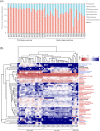Marked variations in gut microbial diversity, functions, and disease risk between wild and captive alpine musk deer
- PMID: 37421471
- PMCID: PMC10390370
- DOI: 10.1007/s00253-023-12675-1
Marked variations in gut microbial diversity, functions, and disease risk between wild and captive alpine musk deer
Abstract
Maintaining a healthy status is crucial for the successful captive breeding of endangered alpine musk deer (Moschus chrysogaster, AMD), and captive breeding programs are beneficial to the ex-situ conservation and wild population recovery of this species. Meanwhile, the gut microbiota is essential for host health, survival, and environmental adaptation. However, changes in feeding environment and food can affect the composition and function of gut microbiota in musk deer, ultimately impacting their health and adaptation. Therefore, regulating the health status of wild and captive AMD through a non-invasive method that targets gut microbiota is a promising approach. Here, 16S rRNA gene sequencing was employed to reveal the composition and functional variations between wild (N = 23) and captive (N = 25) AMD populations. The results indicated that the gut microbiota of wild AMD exhibited significantly higher alpha diversity (P < 0.001) and greater abundance of the phylum Firmicutes, as well as several dominant genera, including UCG-005, Christensenellaceae R7 group, Monoglobus, Ruminococcus, and Roseburia (P < 0.05), compared to captive AMD. These findings suggest that the wild AMD may possess more effective nutrient absorption and utilization, a more stable intestinal microecology, and better adaption to the complex natural environment. The captive individuals displayed higher metabolic functions with an increased abundance of the phylum Bacteroidetes and certain dominant genera, including Bacteroides, Rikenellaceae RC9 gut group, NK4A214 group, and Alistipes (P < 0.05), which contributed to the metabolic activities of various nutrients. Furthermore, captive AMD showed a higher level of 11 potential opportunistic pathogens and a greater enrichment of disease-related functions compared to wild AMD, indicating that wild musk deer have a lower risk of intestinal diseases and more stable intestinal structure in comparison to captive populations. These findings can serve as a valuable theoretical foundation for promoting the healthy breeding of musk deer and as a guide for evaluating the health of wild-released and reintroduced musk deer in the future. KEY POINTS: • Wild and captive AMD exhibit contrasting gut microbial diversity and certain functions. • With higher diversity, certain bacteria aid wild AMD's adaptation to complex habitats. • Higher potential pathogens and functions increase disease risk in captive AMD.
Keywords: 16S rRNA gene sequencing; Alpine musk deer; Core microbiome; Gut microbial function; Opportunistic pathogens.
© 2023. The Author(s).
Conflict of interest statement
The authors declare no competing interests.
Figures






Similar articles
-
Comparative analysis of gut microbial composition and potential functions in captive forest and alpine musk deer.Appl Microbiol Biotechnol. 2022 Feb;106(3):1325-1339. doi: 10.1007/s00253-022-11775-8. Epub 2022 Jan 17. Appl Microbiol Biotechnol. 2022. PMID: 35037997 Free PMC article.
-
Marked Seasonal Variation in Structure and Function of Gut Microbiota in Forest and Alpine Musk Deer.Front Microbiol. 2021 Sep 6;12:699797. doi: 10.3389/fmicb.2021.699797. eCollection 2021. Front Microbiol. 2021. PMID: 34552569 Free PMC article.
-
Analysis on Changes and Influencing Factors of the Intestinal Microbiota of Alpine Musk Deer between the Place of Origin and Migration.Animals (Basel). 2023 Dec 8;13(24):3791. doi: 10.3390/ani13243791. Animals (Basel). 2023. PMID: 38136828 Free PMC article.
-
Environmental factors and gut microbiota: Toward better conservation of deer species.Front Microbiol. 2023 Mar 7;14:1136413. doi: 10.3389/fmicb.2023.1136413. eCollection 2023. Front Microbiol. 2023. PMID: 36960286 Free PMC article. Review.
-
Changes in the gut microbiota of osteoporosis patients based on 16S rRNA gene sequencing: a systematic review and meta-analysis.J Zhejiang Univ Sci B. 2022 Dec 15;23(12):1002-1013. doi: 10.1631/jzus.B2200344. J Zhejiang Univ Sci B. 2022. PMID: 36518053 Free PMC article.
Cited by
-
Gut microbiome reveals the trophic variation and significant adaption of three sympatric forest-dwelling ungulates on the eastern Qinghai-Xizang Plateau.BMC Microbiol. 2025 Mar 11;25(1):128. doi: 10.1186/s12866-025-03812-z. BMC Microbiol. 2025. PMID: 40069605 Free PMC article.
-
Insights into the Gut Microbial Diversity of Wild Siberian Musk Deer (Moschus moschiferus) in Republic of Korea.Animals (Basel). 2024 Oct 17;14(20):3000. doi: 10.3390/ani14203000. Animals (Basel). 2024. PMID: 39457930 Free PMC article.
-
Metagenomic comparison of gut communities between wild and captive Himalayan griffons.Front Vet Sci. 2024 May 9;11:1403932. doi: 10.3389/fvets.2024.1403932. eCollection 2024. Front Vet Sci. 2024. PMID: 38784654 Free PMC article.
-
Comparative Analysis of Gut Microbiota Between Wild and Captive Guizhou Snub-Nosed Monkey (Rhinopithecus brelichi).Ecol Evol. 2024 Dec 10;14(12):e70690. doi: 10.1002/ece3.70690. eCollection 2024 Dec. Ecol Evol. 2024. PMID: 39664719 Free PMC article.
References
MeSH terms
Substances
Grants and funding
- 2023-ZJ-952Q/Natural Science Foundation of Qinghai
- 2023-ZJ-901T/Natural Science Foundation of Qinghai
- U20A2012/National Natural Science Foundation of China
- XDA23060602/Strategic Priority Research Program of the Chinese Academy of Sciences
- LHZX-2020-01/Joint Grant from Chinese Academy of Sciences-People's Government of Qinghai Province on Sanjiangyuan National Park
LinkOut - more resources
Full Text Sources

